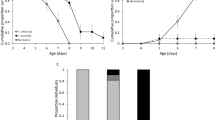Summary
Invertebrate predators and parasitoids have long been characterized as having a hyperbolic (Type 2) functional response. Modifications were made to Holling's sand paper disc experiment which consisted of limiting the initial period of search during which a host must be contacted. Failure to contact a host during this initial period causes the predator to emigrate from the search area. The modification generated a sigmoid (Type 3) functional response. This response resulted from the low probability of encountering a host during the initial period of search at low host densities in the time allotted. A limited period of search has been found in several insect parasitoids. Such a strategy would minimize the time (energy) spent per offspring produced by minimizing the time invested in searching microhabitats in which hosts are scarce or absent.
Similar content being viewed by others
Literature Cited
Burnett, T. (1954) Influence of natural temperatures and controlled host densities on oviposition of an insect parasite.Physiol. Zool.27: 239–248.
Burnett, T. (1956) Effects of natural temperatures on oviposition of various numbers of an insect parasite (Hymenoptera: Chalcidoidae, Tenthredinidae).Ann. Entomol. Soc. Amer.49: 55–59.
Chant, D. A. (1961) The effect of prey density on prey consumption and oviposition in adults ofTyphlodromus (T.)occidentalis Nesbitt (Acarina: Phytoseiidae) in the laboratory.Can. J. Zool.39: 311–315.
Cook, R. M. andS. F. Hubbard. (1977) Adaptive searching strategies in insect parasites.J. Anim. Ecol.46: 115–125.
DeBach, P. andH. S. Smith. (1941) The effect of host density on the rate of reproduction of entomophagous parasites.J. Econ. Entomol.34: 741–745.
Emlen, J. M. (1973)Ecology: An evolutionary approach. Addison-Wesley Publ. Co., Reading, Mass. 493 pp.
Griffiths, K. J. (1969) The importance of coincidence in the functional and numerical responses of two parasites of the European pine sawfly,Neodiprion sertifer.Can. Entomol.101: 673–713.
Hassell, M. P., J. H. Lawton andJ. R. Beddington. (1976) The components of arthropod predation. I. The prey death-rate.J. Anim. Ecol.45: 135–164.
Hassell, M. P., J. H. Lawton andJ. R. Beddington (1977) Sigmoid functional responses by invertebrate predators and parasitoids.J. Anim. Ecol.46: 249–262.
Holling, C. S. (1959a) The components of predation as revealed by a study of small mammal predation of the European pine sawfly.Can. Entomol.91: 293–320.
Holling, C. S. (1959b) Some characteristics of simple types of predation and parasitism.Can. Entomol.91: 385–398.
Holling, C. S. (1965) The functional response of predators to prey density and its role in mimicry and population regulation.Mem. Entomol. Soc. Can.45: 1–60.
Messenger, P. A. (1968) Bioclimatic studies of the aphid parasitePraon exosoletum. 1. Effects of temperature on the functional response of females to varying host densities.Can. Entomol.100: 728–741.
Murdoch, W. W. (1973) The function response of predators.J. Appl. Ecol.10: 335–342.
Murdoch, W. W. andH. Oaten. (1975) Predation and population stability.Adv. Ecol. Res.9: 2–125.
Pianka, E. R. (1974)Evolutionary Ecology. Harper and Row, New York. 356 pp.
Solomon, M. E. (1949) The natural control of animal populations.J. Anim. Ecol.18: 1–35.
Takahashi, F. (1968) Functional response to host density in a parasitic wasp, with reference to population regulation.Res. Pop. Ecol.10: 54–68.
Thompson, D. J. (1975) Towards a predator-prey model incorporating age structure: the effects of predator and prey size on the predation ofDaphnia magna byIschnura elegans.J. Anim. Ecol.44: 907–916.
van Lenteren, J. C. andK. Bakker. (1976) Functional responses in invertebrates.Neth. J. Zool.26: 567–572.
van Lenteren, J. D. andK. Bakker (1978) Behavioral aspects of the functional responses of a parasite (Pseudeucoila bochei Weld) to its host (Drosophila melanogaster).Neth. J. Zool.28: 213–233.
Vinson, S. B. (1976) Host selection by insect parasitoids.Ann. Rev. Entomol.21: 109–133.
Author information
Authors and Affiliations
Additional information
The work was supported in part by NSF Grant DEB-75-04223 and by a grant from the Netherlands Dranization for the Advancement of Pure Research (ZWO).
Rights and permissions
About this article
Cite this article
Luck, R.F., van Lenteren, J.C., Twine, P.H. et al. Prey or host searching behavior that leads to a sigmoid functional response in invertebrate predators and parasitoids. Res Popul Ecol 20, 257–264 (1979). https://doi.org/10.1007/BF02512631
Issue Date:
DOI: https://doi.org/10.1007/BF02512631




